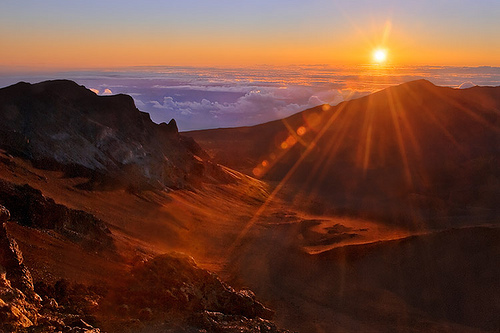Blog
News, updates, finds, stories, and tidbits from staff and community members at KAHEA. Got something to share? Email us at: kahea-alliance@hawaii.rr.com.
Hawaiians, mountain in 'Avatar'-like struggle
From Marti:
Great editorial in the Sacramento Bee yesterday about the analogies between the struggle depicted in the movie Avatar and the real world struggle to protect the last pristine plateau of Mauna Kea. Here’s a quote:
The California astronomers’ “unobtanium” quest – research papers revealing “the secrets of the universe” and identifying planets beyond our solar system – is certainly more noble than mining minerals, but it’s another example of promoting one culture’s notion of progress by overriding another’s reverence for the land. As in the movie, behind the Mauna Kea invaders stands the big money of a starry-eyed entrepreneur, Intel co-founder and telescope donor Gordon Moore.
Particularly rich was the comment posted by Richard Ha about the importance of process. Totally agree, Uncle, which is why we oppose a plan to manage the summit conservation district that is written by the lead-developer of the summit. Just as one example, the plan puts no limit on the number of telescopes that could be built on the summit.
This is not surprising. For decades, the University of Hawaii has promised to better protect the natural and cultural resources of the summit while actively destroying them. This TMT+CMP combo is just the latest example.
Arguments supporting telescope are fallacies
From Alana:
The following letter to the editor, published in The Maui News newspaper, plainly shows that the logic UH uses to defend its proposed telescope is very flawed.
A fallacious argument is made that because Hawaiians revered astronomy, then anything done in the 21st century with respect to astronomy is automatically consistent with Hawaiian spirituality. It’s like saying because Hawaiians revere kalo and because a company wants to genetically modify kalo they’re actually not at cross purposes – they both have proper respect for kalo, they’re just looking at it differently. That logic is unacceptable!
It is also unacceptable logic that infers that during the 19th century period of Hawaiian monarchy, Kalakaua introduced telescopes to Hawaii and he would be – and we should be – in favor of the ATST. Well, Kalakaua also introduced electricity to Hawaii. Shouldn’t we, by the same logic, light up Maui – or at least the top of Haleakala – at night with electric lights? Of course not!
For Kiope Raymond’s entire analysis click here.
Action Alert: Unite to Save the Scared Summits!
 Plans for major construction in the sensitive ecosystems of our most sacred summits continue to push forward, despite significant opposition from the community. The University of Hawaii has filed two environmental impact statements — one for the world’s largest telescope in the world’s only tropical alpine desert, and another for a duplicative solar telescope in one of the most threatened national parks in the U.S. Both of these projects can be built in less sensitive areas.
Plans for major construction in the sensitive ecosystems of our most sacred summits continue to push forward, despite significant opposition from the community. The University of Hawaii has filed two environmental impact statements — one for the world’s largest telescope in the world’s only tropical alpine desert, and another for a duplicative solar telescope in one of the most threatened national parks in the U.S. Both of these projects can be built in less sensitive areas.
Though both summits are protected as conservation districts, where the law expressly discourages construction, the University refuses to compromise, insisting that these giant, intrusive structures be built where they will cause the most harm.
Don’t let good science be used to justify unnecessary ecological destruction and cultural disrespect. Take action now to defend our sacred, fragile summits.
1)
Protect Haleakala — the House of the Sun — from another, unnecessary solar telescope
2) Defend the Sacred Summit of Mauna Kea from the World’s Largest Telescope
Public hearings on the proposal to build the world’s largest telescope on Mauna Kea are being held now. All meetings are 5 to 8 p.m., with an open house in the beginning, followed by formal presentations, and then comments from the public.
Public Hearings on the New Mauna Kea Telescope Proposal
June 16 (Tuesday) Waimea – Waimea Elementary School Cafeteria
June 17 (Wednesday) Hilo – Hilo High School Cafeteria
June 18 (Thursday) Puna – Pahoa High School Cafeteria
June 22 (Monday) Ka’u – Ka’u High/Pahala Elementary School Cafeteria
June 23 (Tuesday) Hawi – Kohala Cultural Center
June 24 (Wednesday) Kona – Kealakehe Elementary School Cafeteria
June 25 (Thursday) Honolulu – Farrington High School Cafeteria
The Draft EIS is available on the Project website – www.TMT-HawaiiEIS.org – and hard copies can be found at public libraries throughout Hawaii.
Get action alerts like these sent directly to your inbox by signing up with KAHEA’s action alert network at www.kahea.org.





